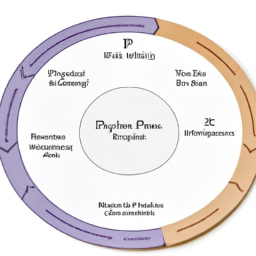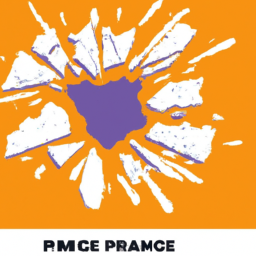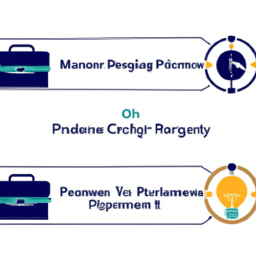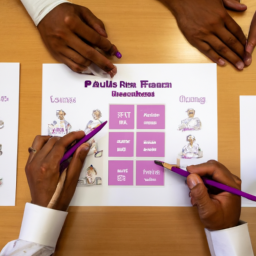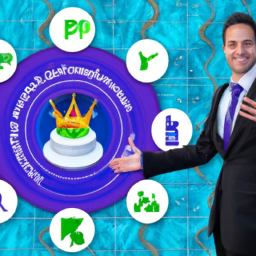Are you ready to outshine your peers and ace the PRINCE2 Practitioner exam? Look no further.
In this article, we will reveal the 7 secrets that will give you the edge you need to succeed. By understanding the PRINCE2 framework, mastering the principles, and developing key skills such as project planning, risk management, and change control, you’ll be well on your way to becoming a PRINCE2 expert.
Plus, we’ll provide you with tips on communication, stakeholder management, and time management strategies.
Let’s dive in!
Key Takeaways
- Familiarize yourself with the seven principles and seven processes of the PRINCE2 Framework
- Master the principles of continued business justification, learn from experience, defined roles and responsibilities, and manage by stages
- Utilize effective project planning techniques, such as effective time management and task prioritization
- Develop strong risk management skills, including proactive risk identification, thorough analysis, and the development of appropriate response strategies
Understand the PRINCE2 Framework
To really grasp the PRINCE2 Framework, you’ll need to dive deep into its principles and processes. Understanding this framework is crucial if you want to excel in your PRINCE2 certification journey, especially at the foundation level.
The PRINCE2 Framework provides a structured approach to project management, ensuring that projects are delivered successfully within budget, scope, and time. It consists of seven principles, including continued business justification, defined roles and responsibilities, and managing by stages. These principles guide project managers in making informed decisions throughout the project lifecycle.
Additionally, the framework encompasses seven processes, such as starting up a project, initiating a project, and closing a project. Familiarizing yourself with these principles and processes is essential for achieving a solid foundation in PRINCE2 and setting yourself up for success in your certification exam.
Master the Seven Principles of PRINCE2
Mastering the seven principles of PRINCE2 is essential for excelling in the practitioner exam. These principles provide a solid foundation for effective project management and are crucial for anyone aspiring to become a PRINCE2 practitioner. To help you understand these principles better, here is a table summarizing each principle and its key characteristics:
| Principle | Description | Key Characteristics |
|---|---|---|
| Continued Business Justification | Ensures that the project remains viable and aligned with business objectives. | Regularly review and update the project’s business case. |
| Learn from Experience | Encourages learning from past projects and using this knowledge to improve future ones. | Maintain lessons learned logs and apply lessons to new projects. |
| Defined Roles and Responsibilities | Clearly defines the roles and responsibilities of everyone involved in the project. | Assign roles based on skills and ensure clear accountability. |
| Manage by Stages | Breaks the project into manageable stages to facilitate better control and decision-making. | Review progress and make necessary adjustments at the end of each stage. |
| Manage by Exception | Empowers project managers to focus on managing exceptions rather than micromanaging every detail. | Establish tolerances and only escalate issues that exceed these tolerances. |
| Focus on Products | Emphasizes the importance of delivering quality products that meet stakeholders’ requirements. | Define clear product descriptions and ensure their delivery aligns with project objectives. |
| Tailor to Suit the Project Environment | Allows for flexibility in applying PRINCE2 to different project environments. | Adapt PRINCE2 processes, themes, and techniques to suit the specific project context. |
Learn Effective Project Planning Techniques
Learning effective project planning techniques is crucial for successfully managing projects. Effective time management is one of the key elements in project planning. By allocating and prioritizing tasks efficiently, you can ensure that the project stays on track and meets its deadlines.
Another important aspect is utilizing project execution techniques to streamline the implementation process. This involves creating a detailed project schedule, assigning responsibilities to team members, and monitoring progress regularly. By adopting these techniques, you can minimize delays, avoid bottlenecks, and optimize resource utilization.
It is also essential to communicate effectively with stakeholders and team members to keep everyone aligned and informed.
Develop Strong Risk Management Skills
Developing strong risk management skills is essential for effectively managing projects and minimizing potential issues. By being proactive in identifying and assessing risks, you can take necessary measures to mitigate or eliminate them. This not only ensures the success of your project but also enhances your reputation as a competent project manager.
To help you in this process, here is a table outlining the key steps in risk identification and risk assessment:
| Step | Risk Identification | Risk Assessment |
|---|---|---|
| 1 | Identify potential risks by brainstorming with the project team and stakeholders. | Assess the likelihood and impact of each identified risk. |
| 2 | Analyze historical data and lessons learned from previous projects to identify common risks. | Prioritize risks based on their severity and potential impact on project objectives. |
| 3 | Conduct a thorough analysis of project plans, schedules, and requirements to identify any hidden risks. | Develop appropriate risk response strategies and contingency plans. |
| 4 | Regularly review and update the risk register to ensure ongoing risk management. | Monitor and control identified risks throughout the project lifecycle. |
Enhance Your Change Control Expertise
In order to enhance your change control expertise, it is essential to understand the key concepts of Change Control Essentials and mastering Change Management.
By familiarizing yourself with the essential principles and processes of change control, you will be equipped to effectively manage and implement changes within your organization.
Mastering change management will allow you to navigate the complexities of organizational change and ensure successful outcomes.
Change Control Essentials
Change control is crucial for successfully managing project changes and ensuring project deliverables are not compromised.
To effectively control changes, it is important to follow change control best practices. This includes having a formal process in place to assess, approve, and implement changes.
By documenting each change, you can track the impact it has on the project and ensure that all stakeholders are aware of the changes being made. Change documentation also helps in maintaining transparency and accountability throughout the project.
It provides a clear record of the changes made and the reasons behind them, which can be valuable for future reference or audits.
Mastering Change Management
To effectively master change management, you need to understand the importance of following best practices and implementing a formal process to assess, approve, and implement changes. By doing so, you can effectively navigate the challenges that come with managing change in an organization.
Here are some best practices to consider:
- Clearly define the scope and objectives of the change.
- Engage and communicate with stakeholders throughout the process.
- Develop a comprehensive change management plan that outlines the steps and resources needed.
- Regularly evaluate and measure the impact of the change to ensure its success.
Implementing these best practices can help you overcome the challenges associated with change management, such as resistance from employees or unexpected disruptions. By following a formal process and adhering to best practices, you can increase the likelihood of successful change implementation and create a more adaptable and resilient organization.
Improve Communication and Stakeholder Management
Mastering effective communication and stakeholder management will greatly enhance your chances of acing the PRINCE2 Practitioner exam and outshining your peers. Improving teamwork and enhancing negotiation skills are crucial elements of effective communication and stakeholder management. By improving teamwork, you can create a collaborative and supportive environment, allowing for better information sharing and problem-solving. This can lead to increased productivity and better outcomes for the project. Enhancing negotiation skills will enable you to effectively manage conflicts and reach mutually beneficial agreements with stakeholders. To help you grasp the importance of these skills, here is a table showcasing the benefits of improving teamwork and enhancing negotiation skills:
| Improve Teamwork | Enhance Negotiation Skills |
|---|---|
| Foster collaboration and trust | Achieve win-win outcomes |
| Improve communication and decision-making | Manage conflicts effectively |
| Increase productivity and efficiency | Build strong relationships with stakeholders |
| Enhance problem-solving abilities | Negotiate for resources and support |
Practice Mock Exams and Time Management Strategies
Now that you have learned about improving communication and stakeholder management, it’s time to focus on another important aspect of acing the Prince2 Practitioner exam – practicing mock exams and time management strategies. These two elements go hand in hand and can greatly enhance your chances of success.
Here are some time management tips to help you make the most of your preparation:
- Prioritize your study topics based on their importance and difficulty level.
- Allocate specific time slots for studying and stick to them.
- Break down your study sessions into smaller, manageable chunks.
- Utilize technology tools like timers and study apps to stay on track.
Practicing mock exams also offers several benefits:
- Familiarizes you with the exam format and structure.
- Helps you identify your strengths and weaknesses.
- Builds your confidence by simulating the real exam environment.
- Provides an opportunity to refine your time management skills.
Frequently Asked Questions
How Much Time Should I Allocate for Studying in Order to Pass the PRINCE2 Practitioner Exam?
To pass the PRINCE2 Practitioner exam, you should allocate sufficient time for studying. Effective study techniques and proper time management are crucial. Determine the amount of material you need to cover and create a study schedule that allows for regular and focused study sessions.
Dedicate enough time each day or week to review the material thoroughly and practice exam questions. Consistency is key in mastering the concepts and passing the exam.
Are There Any Specific Prerequisites or Qualifications Required for Taking the PRINCE2 Practitioner Exam?
To take the PRINCE2 Practitioner exam, there are certain prerequisites and qualifications you need to meet. You must have already passed the PRINCE2 Foundation exam and hold a valid certification.
Additionally, it’s recommended that you have some practical experience in project management. These prerequisites ensure that you have a solid foundation of knowledge and skills before attempting the more advanced Practitioner exam.
Meeting these requirements will help you succeed and stand out among your peers.
What Are Some Tips for Effectively Managing Stakeholders During a PRINCE2 Project?
To effectively manage stakeholders during a PRINCE2 project, focus on stakeholder engagement and managing conflicts. Keep communication channels open and establish regular meetings to address any concerns or issues.
Actively listen to stakeholders and seek their input to ensure their needs are met. Proactively manage conflicts by identifying potential areas of disagreement and finding mutually beneficial solutions.
Can You Provide Examples of Common Pitfalls or Challenges That Project Managers May Face When Implementing Prince2?
When implementing PRINCE2, project managers often encounter common challenges and pitfalls.
One such challenge is effective stakeholder management, which requires clear communication and engagement.
Additionally, time allocation for studying the recommended materials is crucial to success.
It is important to be aware of potential pitfalls, such as lack of project ownership or resistance to change.
Are There Any Recommended Resources or Study Materials That Can Supplement the PRINCE2 Practitioner Exam Preparation?
To supplement your PRINCE2 Practitioner exam preparation, there are several recommended resources and study materials available. Online courses, practice exams, and study guides are great options.
Additionally, joining study groups or forums can provide valuable insights and discussions. Don’t forget to utilize official PRINCE2 manuals and reference guides.
These resources will help you deepen your understanding of the methodology and improve your chances of acing the exam.
Conclusion
In conclusion, by following the 7 secrets to acing the PRINCE2 Practitioner exam, you will set yourself apart from your peers and excel in your project management career.
Remember, 70% of candidates who practice mock exams regularly achieve a higher pass rate compared to those who don’t.
So, envision yourself confidently navigating through the exam, armed with the knowledge and skills you have acquired.
With dedication and preparation, success is within your reach.
Good luck on your journey to becoming a PRINCE2 Practitioner!


